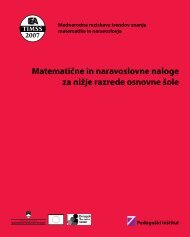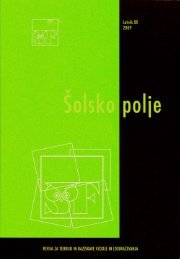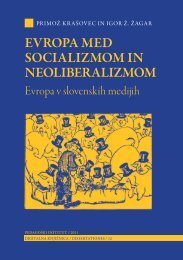Šolsko polje, letnik XX, številka 5-6, 2009: Vloga ... - Pedagoški inštitut
Šolsko polje, letnik XX, številka 5-6, 2009: Vloga ... - Pedagoški inštitut
Šolsko polje, letnik XX, številka 5-6, 2009: Vloga ... - Pedagoški inštitut
You also want an ePaper? Increase the reach of your titles
YUMPU automatically turns print PDFs into web optimized ePapers that Google loves.
54 ŠOLSKO POLJE LETNIK <strong>XX</strong> ŠTEVILKA 5/6Three topoi are mentioned: topos of diversity, topos of history and toposof difference. Surprisingly, only the topos of history is listed and explainedin the list of topoi on p. 44: »Topos of History - because history teachesthat specific actions have specific consequences, one should perform oromit a specific action in a specific situation.« The absence of the othertwo should probably be accounted for with the following explanation onpages 42-43:»These topoi have so far been investigated in a number of studies onelection campaigns (Pelinka and Wodak, 2002), on parliamentary debates(Wodak and van Dijk, 2000), on policy papers (Reisigl and Wodak,2000), on ‘voices of migrants’ (Krzyzanowski and Wodak, 2008), onvisual argumentation in election posters and slogans (Richardson andWodak, forthcoming), and on media reporting (Baker et al., 2008).«But in the study »on visual argumentation in election posters and slogans«,for example, the(se) topoi are not discussed at all, they are presented as afixed list of names (of topoi), without any explanation of their functioning,while the authors (Richardson and Wodak) make occasional referenceto their names (not to the mechanism of their functioning), just asWodak does in the above example from The Discourse of Politics in Action.In argumentation theory, such an »approach« would be called fallacyof circular reasoning (petitio principii).Furthermore, topoi are characterised as (Wodak, <strong>2009</strong>: 43) being applied»to justify and legitimize positions by providing ‘common-places’,instead of substantial evidence«, or »some topoi are used as appeals tohuman rights, to democracy or to justice«, or »topoi are used to promotesuch typical ambiguities, which serve as quasi-argumentative shortcutslinking unclear moves in negotiations, decision-making and so forth.«How all these rather different characterisations are linked to the definitionof topos as a warrant connecting the argument with the conclusion is,once more, not explained, that is all the analysis we get (as far as topoi areconcerned).If, again, topos is to serve the purpose of connecting an argumentwith a conclusion (as respective works emphatically repeat), one wouldexpect at least a minimal reconstruction, but there is none. What we seecould be reconstructed as reffering to topoi or evoking them or simplymentioning them, which mostly serves the purpose of legitimating the(already existing) discourse and/or text analysis, but gives little analyticalor theorethical added value in terms of argumentation analysis.
















